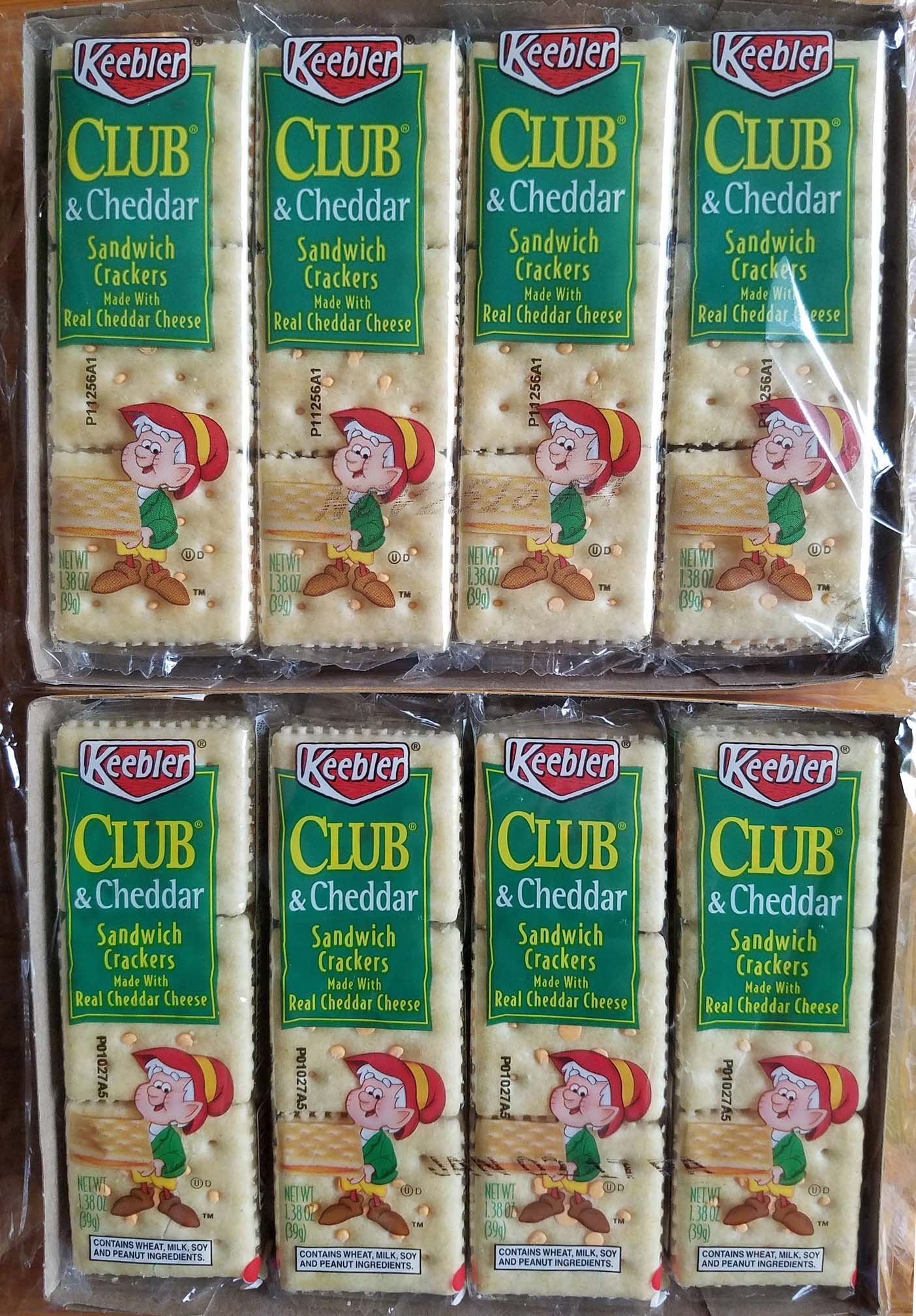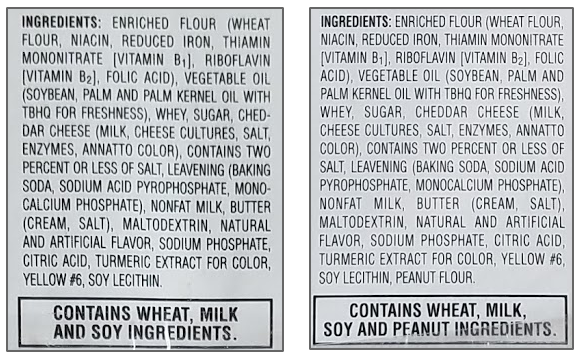Kellogg’s is rolling out their new peanut flour formulations of cracker varieties that were previously considered by many to be peanut “safe”. While the company won’t say why they are doing this, they did assure the public they would clearly mark the new formulations to warn consumers of the change.
We obtained samples of one variety – Keebler Club & Cheddar Sandwich Crackers – before and after the addition of peanut flour so we could compare packages. Here are both for comparison:
 Can you spot the difference? Would you have noticed if one day the top package was replaced by the bottom on your supermarket shelf? There’s no red banner, no “New and Improved” or “Fortified with Peanuts” stamp, nothing but a small “Contains” statement at the bottom that provides no indication that the formulation has changed.
Can you spot the difference? Would you have noticed if one day the top package was replaced by the bottom on your supermarket shelf? There’s no red banner, no “New and Improved” or “Fortified with Peanuts” stamp, nothing but a small “Contains” statement at the bottom that provides no indication that the formulation has changed.
Lest you wonder if the backs of the packages provide some indication, here they are, again back-to-back for comparison:

There’s little noticeably different here unless you’ve been warned in advance of the formulation change. Also note that Kellogg’s inadvertently distracts you from the new peanut disclosure by including a “Collect Points” graphic.
Here are is a comparison of the front packages, zoomed in to show the difference. If you were observant enough to notice the statement at all, you might have thought this was simply a new way of labeling as there is no indication that the formulation itself has changed:

Here’s a comparison of the ingredient labels:

Again, there is no warning that the formulation has changed. But note that peanut flour is the last ingredient listed on the second label – after Yellow #6 and Soy Lecithin – indicating that only a minute quantity of the allergen has been introduced. This lends credence to conjecture that Kellogg’s is adding peanuts to avoid the costs of complying with new Food Safety Modernization Act directives intended to make foods safer.
Kellogg’s actions show a marked disdain for allergic consumers by preferring cost savings over the safety of the allergic community they claim to value, and there is no reason to believe they will not employ similar methods across their entire product line in order to protect their profit margins.
What You Can Do
Tell Kellogg’s their actions are unacceptable by signing and distributing the Change.org petition that has already garnered over 23,000 signatures. Become the local champion to this cause by contacting your local TV and radio stations, newspapers, and websites. Tweet, e-mail and voice (1-800-962-1413) your concerns to Kellogg’s.
Get involved before other companies follow Kellogg’s lead!
Other articles related to Kellogg's Action:
- Media Briefing: Kellogg’s Intentionally Adding Allergens to Products
- Petition to Kellogg’s: Do NOT Add Peanut Flour to Your Products
- Adding Insult to Injury: Kellogg’s Botches Warning to Allergic Consumers
- Is Kellogg’s Putting the Allergic at Risk to Avoid the Costs of the FSMA?
- Kellogg’s: Potential for Injury, Illness and Death is a Cost of Doing Business
- Kellogg’s Responds to Petition with Even More Dangerous Plan
- Video: Kellogg’s Petition at 15,000 Signatures
- Press Release: Kellogg’s: Don’t Add Peanut Flour to Existing Products






Thank you for working so hard on giving my 5yr old grandson a voice!! Holding large companies accountable for their choices, informing companies of harm or better ways, informing the public, helping parents…and on and on!! Even if just a thank you from me, I hope it is worth it! Thank you!
Thank you so much for your efforts to keep our kids safe.
Thank you so much for all you do to raise awareness and try to keep our kids safe.
Yes, I would notice the new warning because I can READ. Perhaps others should learn to do so as well – without a red banner, screaming banshee or club over the head. Stop blaming companies for adult’s inattention. If you our your child has a dangerous allergy it is YOUR responsibility to read the labels and warnings.
I agree, Michael. It’s our job to check labels every.single.time. The outrage refrain I keep seeing is centered on the person that grabs a pack assuming what was safe is still safe. That mistake would be on the person grabbing the package – not the company. It’s up to *us* to check all labels. every. single. time. Let’s take responsibility and let’s please get our story telling straight. These crackers have an allergy call out on the front AND back. That’s not “nothing.”
Well, I guess you should not expect warnings from the FDA on Listeria outbreaks on your vegetables as you should KNOW to wash them first!! This is about a LONG around product that is CHEESE cracker changing (for no reason) to include peanut flour!!!! Who would ever think “Hmmm I have been eating these CHEESE crackers and have previously checked the label, but now I think I have the feeling they might contain PEANUTS” SMH! Yes, we should read labels every single time and make calls, emails, etc. BUT a big company like Kellogg’s should also play a responsible role in this as well. They have a HUGE allergy department and know all to well that doing this would put children at risk, whether by eating them or being next to a child unknowing eating peanut flour cheese crackers…and they therefor should have taken a more responsible approach to label clearly “NEW, now with peanut flour”!!
Seriously? Your own photos in this story show an allergen statement on the front AND on the back. We, as adults with food allergies or food allergic children, are responsible for checking labels every.single.time. To suggest a company is liable because we might FAIL to do OUR JOB is insane. Kellogg made a recipe change. Why they made that change is really, quite frankly, inconsequential. They made a change. AND they notified the allergy community through a variety of channels which is more than they are required to do. They have placed a call out box on the front AND back of the package. If you or I can’t figure out that this package is not safe – if we fail to check every label, every time after they announce that a change is coming – well that is on us.
You would have to be the person who typed it to know it changed
I’m going to agree with the majority on this one. I check every single thing that I buy for my nut-allergic child, including things that I have safely purchased in the past. Yes, I would absolutely notice the new label on the front AND the one on the back. It is absolutely on us as parents to check the labels of everything we buy, no matter how many times we have bought it in the past.